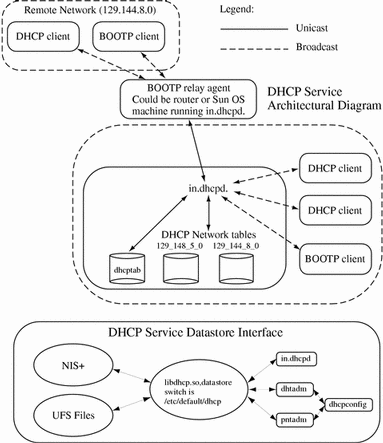What is DHCP?
DHCP provides a host with an Internet Protocol (IP) address and other Internet configuration parameters without any need for preconfiguration by the user. This new protocol improves on the traditional Internet architecture, where the system administrator must assign or change each IP address individually. The manual process is expensive, difficult, error-prone and time-consuming.
DHCP reduces the cost of managing networks by eliminating the need for the administrator to assign or change IP addresses again and again. Dynamic IP addresses are chosen from a pool of unused IP addresses, and are automatically assigned to a host for temporary or permanent use. DHCP also reclaims that IP address for use by other clients when it is no longer needed or when the time period for its use is up.
The packet formats for DHCP and BOOTP are the same, although BOOTP packets are fixed length and DHCP packets are variable length. The DHCP packet length is negotiated between the client and the server.
The Dynamic Host Configuration working group of the Internet Engineering Task Force (IETF) has been working for approximately five years on the problems presented by the current IP address assignment architecture. The IETF is in the process of standardizing DHCP. It currently has the status of several Requests For Comment (RFCs), including RFCs 1542, 2131, and 2132.
The Internet has grown so rapidly that users are running out of network addresses to support it. In response to this problem, Classless Inter-Domain Routing (CIDR) was developed. IP addresses had been separated into class A, B, and C for large, medium, and small networks. As the class B IP addresses were depleted, the CIDR design came into use. CIDR was based on the idea that an organization should get the exact number of class C IP addresses it needs, rather than be assigned one class B network, consisting of 65,536 addresses.
The class C network numbers allocated following the CIDR strategy are not random. They are contiguous and share the same prefixes. This helps alleviate many of the problems caused by manipulating very large routing tables.
With the CIDR strategy, blocks of IP addresses are allocated to individual ISPs, not to individual requestors or companies, as was previously the case. So it becomes important to renumber easily, in order to change ISPs easily. DHCP makes it easy to renumber networks, and therefore easier to change ISPs.
DHCP is a technology that enables several useful features, including:
-
Automatic network configuration, such that after client machines are powered up on a network that supports DHCP, the clients acquire what they need. For example, their IP addresses, default routers, subnet masks, the DNS domain, DNS servers, NIS+ domain, NIS+ servers, Timezones, time servers, and all the other information necessary to operate without any need for individual configuration by an administrator.
-
Automatic IP address management, including assignment, reclamation, reconfiguration, and renumbering of IP addresses. Since all TCP/IP parameters are managed centrally, and the DHCP service manages the assignment and reuse of IP addresses automatically, minimal administrator involvement is necessary.
-
Vastly simplified system administration through the centralized location of network configuration information. The TCP/IP configuration information can be stored in a central place, instead of being distributed among all the clients in the network. A network can be renumbered simply and quickly, usually in only a few days, using relatively short IP address leases.
DHCP can also exploit existing BOOTP relay functionality since DHCP is based on the BOOTP. This permits network administrators to configure their routers to forward BOOTP/DHCP traffic to remote BOOTP/DHCP servers. Therefore, network parameter servers are no longer needed on every network segment, as was true of the in,rarpd (see in.rarpd(1M)) and bootparams configuration services.
A network administrator can use the command to quickly and easily configure DHCP and BOOTP services on a Solaris 2 server. The command bootstraps the DHCP service and configures local and remote networks. Local networks are those to which the server is directly connected. Remote networks are those to which the server is not directly connected, but are accessed through BOOTP relay agents.
Serving clients on remote networks requires the configuration of a BOOTP relay agent on the client's network. BOOTP relay agent functionality is present in many popular routers and switches. If your router does not support this feature, you can run the in.dhcpd daemon (see in.dhcpd(1M)) in relay agent mode on any Solaris 2 machine on the client's network capable of running in.dhcpd. This is true for machines running Solaris 2.6 and later releases. Figure 14-1 shows an overview of DHCP and BOOTP.
Figure 14-1 DHCP Architectural Diagram

- © 2010, Oracle Corporation and/or its affiliates
